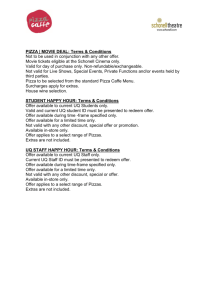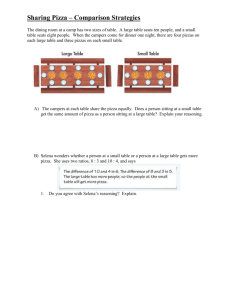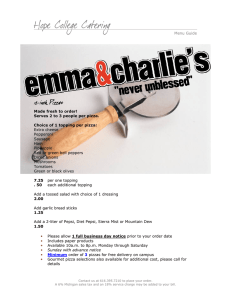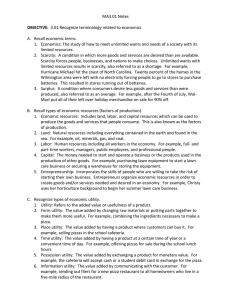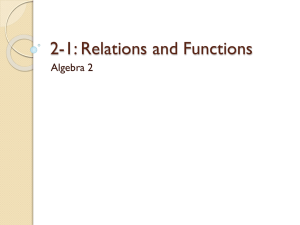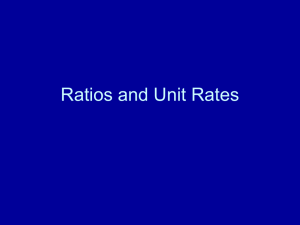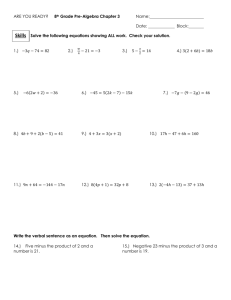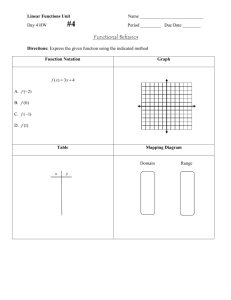20 10
advertisement
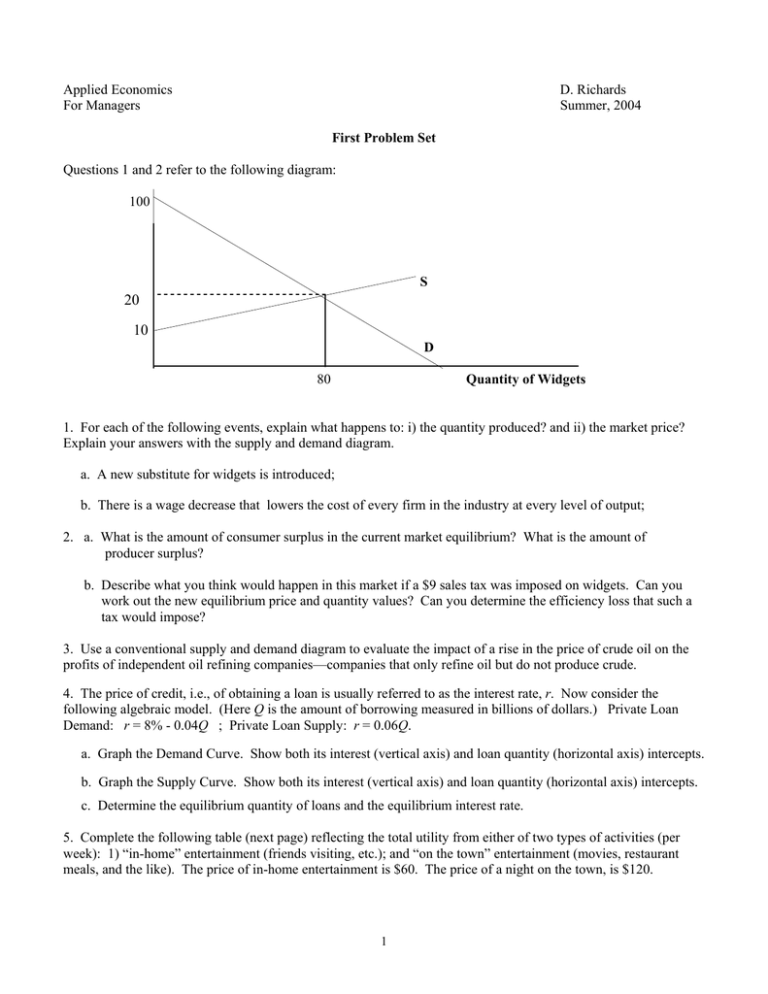
Applied Economics For Managers D. Richards Summer, 2004 First Problem Set Questions 1 and 2 refer to the following diagram: 100 S 20 10 D 80 Quantity of Widgets 1. For each of the following events, explain what happens to: i) the quantity produced? and ii) the market price? Explain your answers with the supply and demand diagram. a. A new substitute for widgets is introduced; b. There is a wage decrease that lowers the cost of every firm in the industry at every level of output; 2. a. What is the amount of consumer surplus in the current market equilibrium? What is the amount of producer surplus? b. Describe what you think would happen in this market if a $9 sales tax was imposed on widgets. Can you work out the new equilibrium price and quantity values? Can you determine the efficiency loss that such a tax would impose? 3. Use a conventional supply and demand diagram to evaluate the impact of a rise in the price of crude oil on the profits of independent oil refining companies—companies that only refine oil but do not produce crude. 4. The price of credit, i.e., of obtaining a loan is usually referred to as the interest rate, r. Now consider the following algebraic model. (Here Q is the amount of borrowing measured in billions of dollars.) Private Loan Demand: r = 8% - 0.04Q ; Private Loan Supply: r = 0.06Q. a. Graph the Demand Curve. Show both its interest (vertical axis) and loan quantity (horizontal axis) intercepts. b. Graph the Supply Curve. Show both its interest (vertical axis) and loan quantity (horizontal axis) intercepts. c. Determine the equilibrium quantity of loans and the equilibrium interest rate. 5. Complete the following table (next page) reflecting the total utility from either of two types of activities (per week): 1) “in-home” entertainment (friends visiting, etc.); and “on the town” entertainment (movies, restaurant meals, and the like). The price of in-home entertainment is $60. The price of a night on the town, is $120. 1 In-home Event # times per week 0 1 2 3 4 5 6 7 On-the-town Event Total Marginal Utility Utility # times per week MU/P 0 400 780 1100 1380 1500 1600 1650 0 1 2 3 4 5 6 7 Total Utility Marginal Utility MU/P 0 800 1500 1900 2200 2400 2500 2550 6. Return to Problem 5, above. a. Imagine a “poor” graduate student with a weekly income of $300. What is her optimal allocation of spending between these two activities? What is her total utility with this allocation? b. What would be the graduate student’s allocation if the price of an “On-the-town” event fell to $60? What would be her total utility now? (Work with whole number quantities). Questions 7 and 8 refer to the following diagram: $ Demand MC = AC Quantity 7. Use QC to denote the level of output a perfectly competitive industry will produce. Use QM to denote the level of output that a non-discriminating monopoly will produce. a. Show QC on the diagram. b. Show QM on the diagram. How big is QM relative to QC? c. If unit costs rise, what will happen in a competitive industry to the equilibrium price and quantity? What will happen to total economic profit in the competitive industry? d. If unit costs rise, what will happen in a monopolized industry to the equilibrium price and quantity? What will happen to monopoly profits? 8. Use QMD to show the level of production chosen by a perfectly discriminating monopolist. a. Show QMD on the diagram. b. How does the outcome under perfect competition differ from that under perfectly discriminating monopoly? 2 9. The town of Lineville is located entirely along a 20-mile stretch on Rural Route 999. The population of the town (Pop = 2000) lives in equal-sized, clustered settlements located at one-mile intervals lying east and west of the town center. Each such cluster has 100 people. So, as one proceeds 1 mile east (west) there exists a group of 100 citizens. At the two-mile mark (again, in either direction) there exists another group of 100 citizens, and so on. (See below.) Center 100 100 100 100 100 100 100 100 100 100 100 100 100 100 100 100 100 100 100 100 A very large number of identical firms—each located right next to each other at the center of the city—sell pizza. Citizens of Lineville buy either one or no pizzas each week depending on the price. Each citizen is willing to pay up to $15 for a pizza. However, this includes the cost of transportation. The full price of getting a pizza is the actual price of pizza itself plus $1 for each mile that one lives from the pizza shop. Thus, if pizzas are selling for $10 at the center of town, someone who lives 1 mile from the pizza shop, will pay $11 total after transport costs are included. Someone who lives 5 miles away will pay a total price of $15. The cost of making one pizza is $8 and stays at that level no matter how many pizzas a shop (or all the shops together make). Anyone for whom the full price exceeds $15 will buy no pizzas. a. Assume all pizza shops charge the same price. If this price is $15, how many pizzas will be demanded? If the price falls to $14, how many pizzas will be demanded? Use this process to show that the inverse demand for pizzas may be expressed as: P = $15 – 0.005Q. b. What is the equilibrium price of pizzas in Lineville? What quantity of pizzas will be purchased at this price? c. Suppose that the pizza makers all merge into one giant pizza firm, Dominato’s. Assume again that the cost of producing pizza remains constant at $8. What will be the price of pizzas now and how many pizzas will be consumed at that price? 10. A. J. Munopilee is the owner of Munopilee Air, the only airline currently flying between Erewhon and El Dorado. It flies two roundtrip flights per day, with the average flight being about 85 percent full. A new entrant, UpStart Airways, has announced plans to offer an additional two flights per day in the Erewhon-El Dorado market. However, its entrance must be approved by the PAB (Polite Aeronautics Board). A. J. and his co-directors argue before the PAB that UpStart should not be allowed such entry because Munopilee asserts that UpStart’s entry will only cause both Munopilee and UpStart to fly inefficiently small numbers of passengers—each operating planes that are less than half full. Munopilee points to its current load factor or occupation rate of 85 percent as evidence that the market is not big enough for both carriers to operate efficiently. Evaluate the argument put forward by Munopilee Air. Do you think it is valid or not? 11. Consider the following description of Total Cost (TC): TC = 49q – 8q2 + 0.5q3. a. For values of q from 1 to 15, calculate both average cost and marginal cost. b. Does this cost equation exhibit economies of scale to any extent? Explain. c. What is true about average cost and marginal cost at the value of q that yields the lowest average cost? 12. Return to the cost function of Problem 11 and assume that it describes the cost (per half day) of the typical barber shop in the local barber shop market. Suppose further that each such barber shop market faces an inverse demand curve (again per half day) given by: P = 31 – 2Q. a. Determine the profit-maximizing price for the typical barber and how many haircuts she will perform at that price per half day. b. What will be the typical barber’s profit (per half day)? c. Does the typical barber have an incentive to price discriminate? Explain. 3 13. The Boston Monopoly Transit Authority (BMTA) determines that demand for public transport on its rail lines is negatively affected by fares but is inelastic. Its operating costs fall (slightly) as the number of passengers declines. If it raises its fare, what will happen to: a. Total ridership (the number of riders)? b. The BMTA’s costs? c. The BMTA’s total revenue? d. The BMTA’s net profit (revenue less costs)? 14. Ben Williams owns the only sizable hill in Ocean View, Iowa and uses it to run the local winter ski site. Ben figures he has a fixed cost of $200 per day. He also reckons that giving a ride up the hill costs him an additional but constant amount $2.00 per passenger ride. On any given day, there are 200 such potential passengers each characterized by the identical demand curve: P = $18 - q. a. Ben decides to price his ski lift rides individually, i.e., every time someone rides up the hill they get charged. What price should Ben choose to maximize his profit? What will his profit be at this price? b. Ben reads an Econ book and decides to change his pricing strategy. He now charges all customers a flat fee of $80 just to enter the lift area. However, having paid that fee, skiers can take as many lift rides as they wish at zero charge. Will this strategy raise Ben’s profit? (HINT: What surplus does a consumer earn at a q such that the marginal value of a ride is 0?) 4

